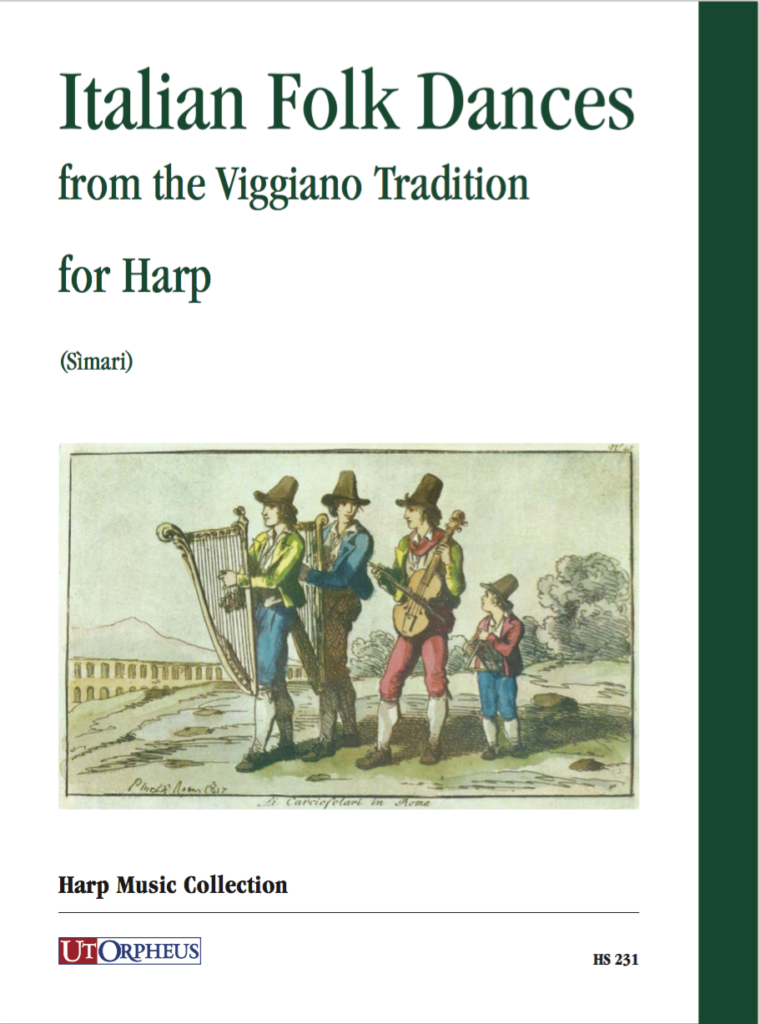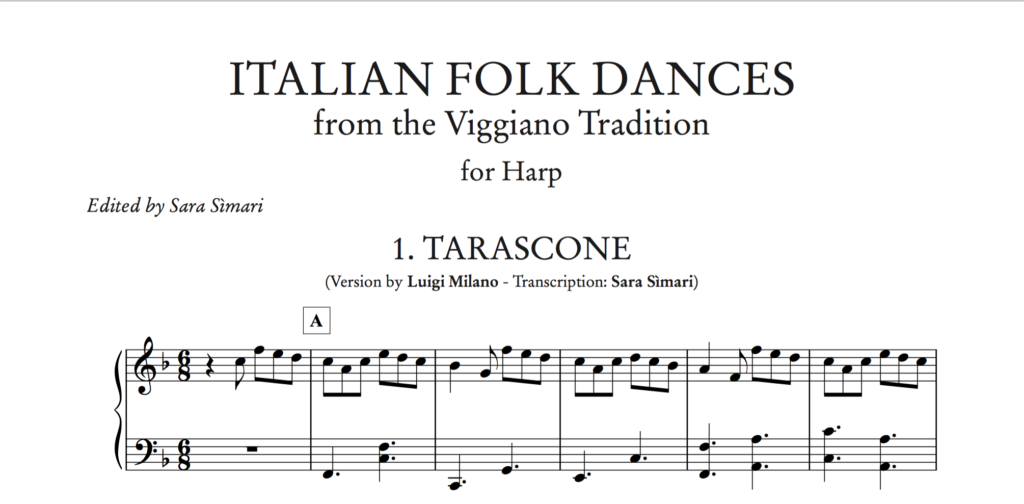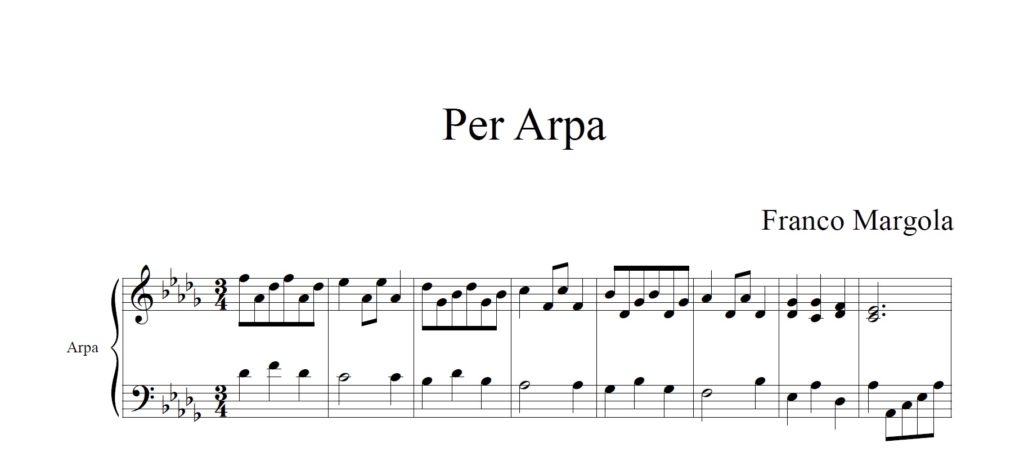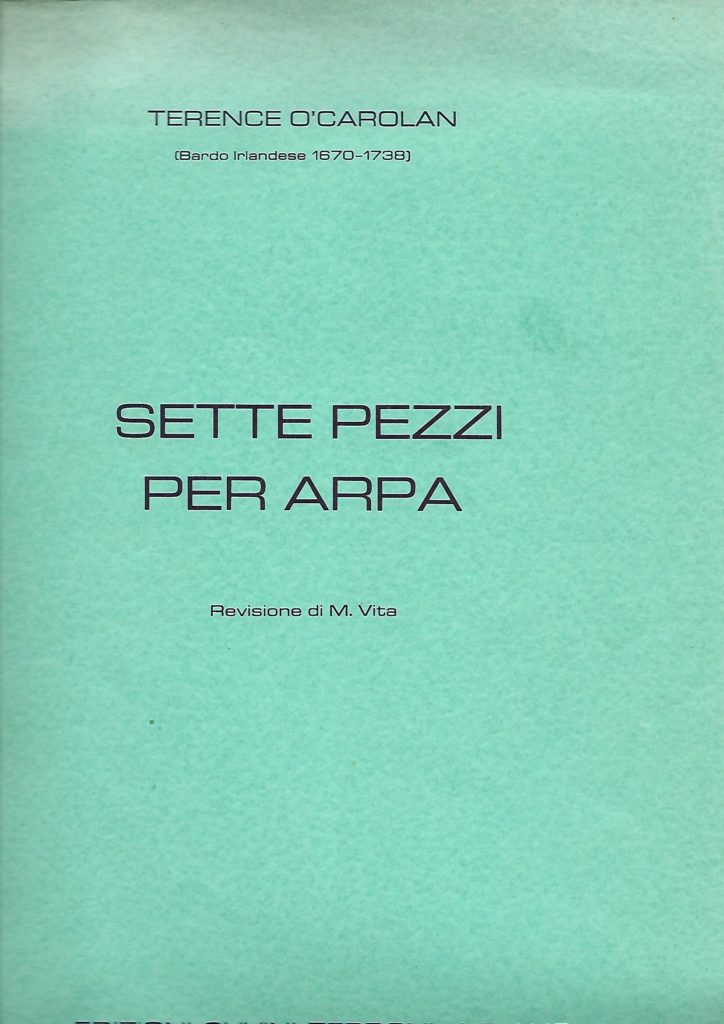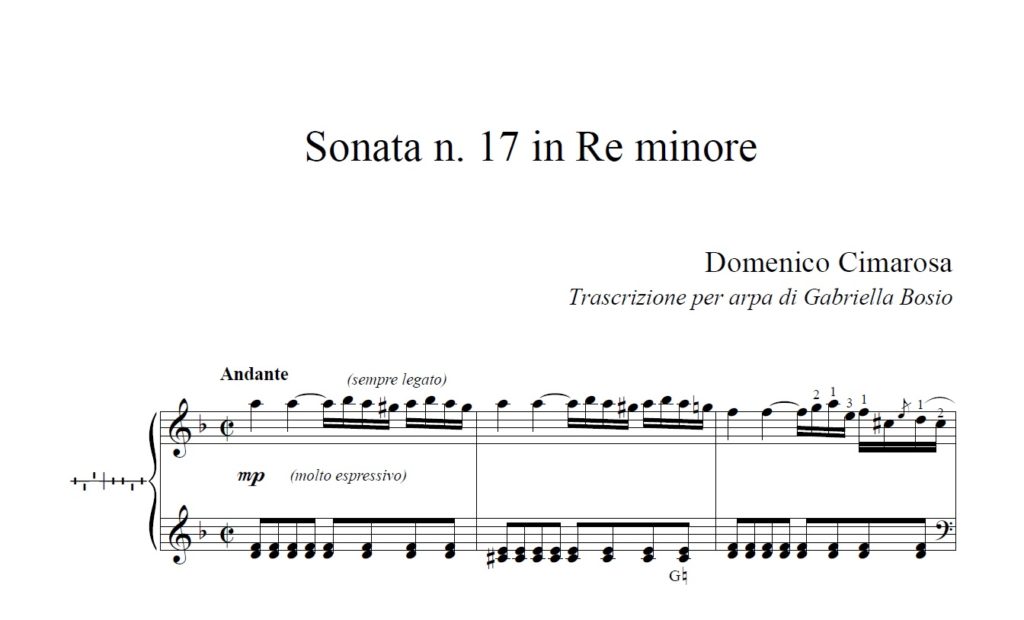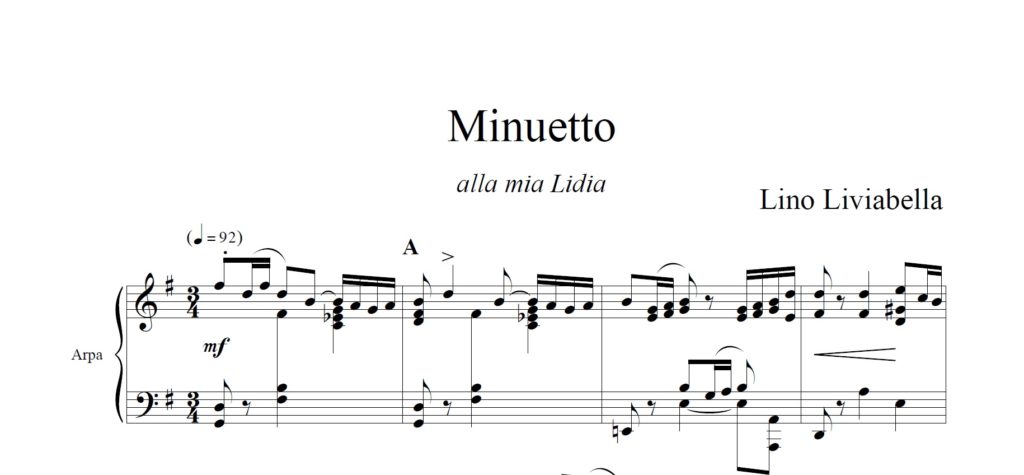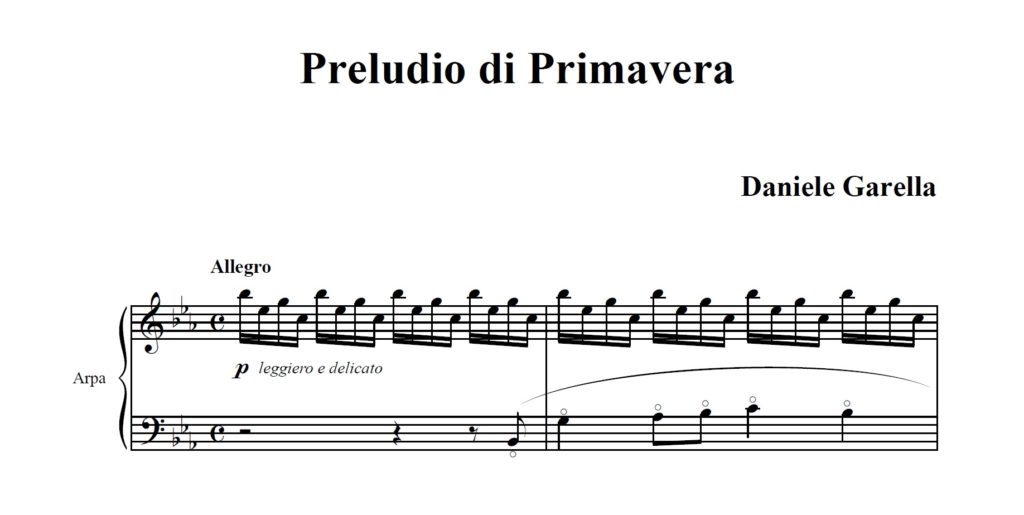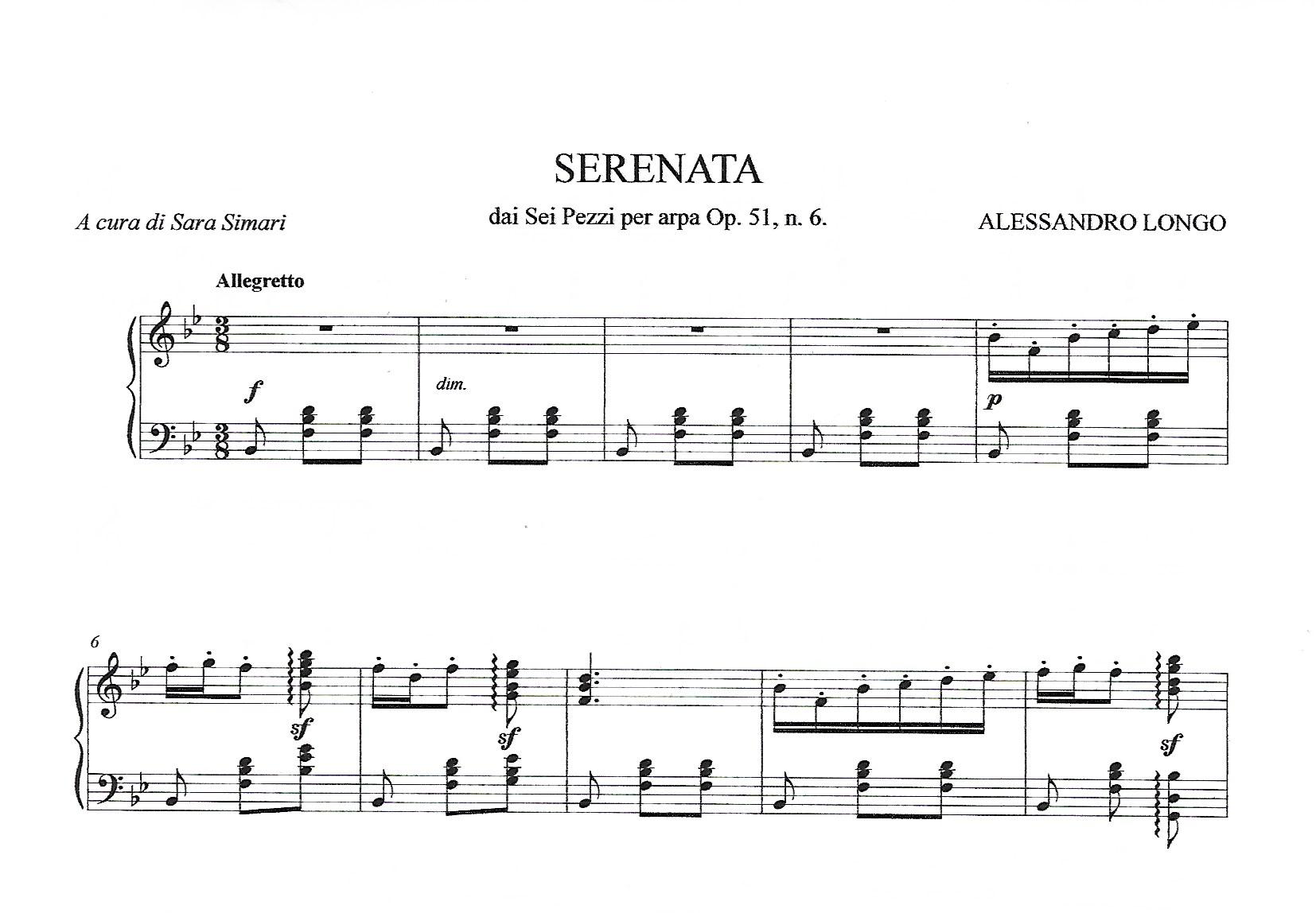Anteprima dei brani in programma al 7th International Harp Contest in Italy Suoni D’Arpa.
Categorie / Categories:
A) Solisti di arpa celtica e a pedali fino a 15 anni / Lever and Pedal Harp soloists up to 15 years old by July 10th, 2017
Programma / Repertoire:
1 pezzo a scelta da “Tradizione dell’arpa popolare viggianese” / One freely chosen composition from “Tradizione dell’arpa popolare viggianese”.
La storia dei Viggianesi, musicanti girovaghi, si snoda in un arco temporale di circa quattro secoli e esprime un ‘unicum’ sul piano musicale quanto su quello antropologico. Se la figura del musicante viggianese prese corpo nella seconda metà del Settecento, è inevitabile scorgerne le origini in una cultura dell’arpa già viva nella capitale del Regno di Napoli, fin dal Basso Medioevo. Immortalati con cura maniacale nei presepi artistici napoletani del Settecento, i girovaghi, impegnati nell’occupazione abituale di specialisti della musica, si presentano ben integrati con la popolazione napoletana di cui soddisfacevano i bisogni in vari ambiti (rituali, cerimoniali, devozionali e ricreativi). All’alba del XX secolo, molti giovani lucani si imposero come qualificati artisti , esprimendosi tra Australia e America in concerti di strada, nei locali più rinomati, nei vaudeville , nelle sale cinematografiche. Alcuni di loro effettuarono studi accademici presso i conservatori più celebri di Napoli e Roma prima di intraprendere carriere clamorose nelle maggiori orchestre del mondo, divenendo virtuosi di fama internazionale, e inoltre liutai, docenti e direttori d’orchestra. Per citare solo alcuni tra gli arpisti: Albert e Victor Salvi, Salvatore Mario De Stefano, Edward Vito, Tommaso Cerbasi. La pubblicazione “Italian Folk Dances from the Viggiano tradition for harp” (disponibile da fine gennaio 2017 nel sito www.utorpheus.com), curata da Sara Simari e Lincoln Almada, entrambi docenti nella Scuola dell’Arpa Viggianese e della Musica che ha sede a Viggiano, contiene cinque brani: Tarascone, Tarantella capuanese, Valzer, Polka di Vittorio e Tarantella stiglianese. I partecipanti al 7th International Harp Contest in Italy Suoni D’Arpa potranno eseguirne uno a libera scelta. I brani (escluso il Tarascone) sono tutti inclusi nel CD Fremer l’arpa ho sentito per via. Canti e danze dalla tradizione Viggianese – Ensemble della Scuola dell’Arpa Viggianese e della Musica (Viggiano) – direzione artistica e musicale di Lincoln Almada e Sara Sìmari – TACTUS Records, TC 800006, 2016. I componenti e i direttori dell’Ensemble effettueranno il concerto di apertura del Festival Suoni D’Arpa, il 2 settembre 2017 a Saluzzo e presso la sede della Fondazione Scuola di Alto Perfezionamento Musicale avrà luogo anche una importante mostra fotografica dedicata a Viggiano a cura dell’Associazione Arpa Viggianese, parner dell’Associazione Italiana dell’Arpa.
The history of the Viggianesi, intinerant musicians covers at least four centuries and is unique, both from a musical point of view and from an anthropogical one. Although the figure of the musician from Viggiano materialised in the second half of the eighteenth century, its origin can be detected in a harp culture that was already alive in the capital of the kingdom, Naples, since the late Middle Ages. The girovaghi, or intinerant musicians, were portrayed with obsessive precision in the Neapolitan artistic crèches of the eighteen century while engaged in their customary occupation of specialists of music : they were throughly integrated in the entire population of Naples, and met its needs in several areas (rites, and cerimonies, devotional activities, recreation). At the beginning of twentieth century many young people from Basilicata emerged in Australia and America as qualified artists, performng in street concerts, renowned venues, vaudevilles and cinemas. Some of them carried out academic studies at the most celebrated conservatories of Naples and Rome, then embarked on brillant careers in the most important orchestras all over the world, and became internationally famous virtuosi, luthiers, teachers and conductors. We will mentions only a few among the harpists: Albert e Victor Salvi, Salvatore Mario De Stefano, Edward Vito, Tommaso Cerbasi. The score of “Italian Folk Dances from the Viggiano tradition for harp”, edited by Sara Simari and Lincoln Almada (available from end January 2017 at www.utorpheus.com), both Professors in the Viggiano Scuola dell’Arpa Viggianese e della Musica, contains five pieces: Tarascone, Tarantella capuanese, Valzer, Polka di Vittorio and Tarantella stiglianese. The participants at the 7th International Harp Contest in Italy Suoni D’Arpa will present one free choice among them. These pieces, excluding Tarascone, are all included in the Tactus CD “Fremer l’arpa ho sentito per via. Canti e danze dalla tradizione Viggianese – Ensemble della Scuola dell’Arpa Viggianese e della Musica (Viggiano)” under the artistic direction of Lincoln Almada and Sara Sìmari (TACTUS Records, TC 800006, 2016).The Ensemble will perform at the Opening Concert of the Festival Suoni D’Arpa (2 September 2017) in Saluzzo, where will be possible to visit a beautiful photo exhibition of the harp history in Viggiano. Our Association will guest our partner “Associazione Arpa Viggianese”.
(Abstract from CD note by Sara Simari)
L’arpa: uno strumento disceso dall’Olimpo, raccolto dalle mani delicate di aristocratiche fanciulle, per la gioia di pittori neoclassici. Così lo rappresentano le immagini della nostra cultura. Immagini ingannevoli: il percorso storico reale portò l’arpa degli dei antichi nelle mani di un popolo di contadini e di pastori e ne fece il simbolo stesso di un borgo sperduto della Basilicata, Viggiano. (Adriano Prosperi, prof. Emerito Classe di Scienze Umane, Scuola Normale Superiore, Pisa)
http://stellamattutinaedizioni.it/7th-international-harp-contest-italy-suoni-darpa/?lang=en
Il Conservatorio di Parma ha celebrato il compositore Franco Margola (1908-1992), attraverso una serie di concerti e conferenze, coronati dalla registrazione di un CD Tactus che uscirà prossimamente. Il breve brano “Per arpa” è pervenuto in un unico esemplare autografo e appartiene all ’ultimo periodo di attività del compositore. Si tratta dell’unica opera per arpa sola da lui composta. L’Associazione Italiana dell’Arpa ringrazia Alfredo Margola, per aver offerto un premio nella categoria A del concorso in cui viene richiesta l’esecuzione di questo gioiello musicale. Lorenzo Montenz ha scritto una accurata presentazione nell’edizione del brano, tratta dal manoscritto.
The Conservatory of Parma celebrated the composer Franco Margola (1908-1992) through a series of concerts and conferences, crowned by the recording of a CD Tactus which will be released shortly. The little piece “Per arpa” was received in one original autograph, and our Association thanks Alfredo Margola, who offers a prize to the young performers in the Competition. The piece belongs to the last period of activity of the composer and is the only work that he wrote for solo harp. Lorenzo Montenz wrote an accurate presentation of this composer in the edition from the manuscript.
Abbiamo voluto onorare la memoria di Mirella Vita con questo suo lavoro pionieristico del 1970. Ringraziamo Clara Rocco per la sua offerta del prezioso premio a nome di Mirella Vita.
We decided to honor the memory of Mirella Vita with this 1970 pioneering work. We thanks Clara Rocco for offering a valuable prize on the name of Mirella Vita.
Terence O’ Carolan (rev. Mirella Vita), from “Sette Pezzi per arpa”: Carolan’s Concerto (www.musicadarpa.it)
I Bardi (in inglese Harpers, da harp, arpa) erano poeti girovaghi dell’Irlanda, del Galles e della Scozia, i quali declamavano i loro poemi alternandoli con l’esecuzione di pezzi per arpa (tunes). Turlogh O’Carolan (1670-1738), cieco, fu uno degli ultimi famosi Bardi irlandesi, e declamava in lingua gaelica. I Bardi avevano una tradizione millenaria, ed il più celebre di loro fu Alfredo il Grande (sec.IX, fondatore dell’Università di Oxford, del quale si racconta che, travestito, fu ammesso nel campo dei Danesi invasori, perchè cantasse e suonasse, e che abbia così potuto ascoltare i progetti strategici dei nemici, sconfiggendoli l’indomani in battaglia. Dapprima l’arpa e la poesia furono privilegio di casta, e solo i notabili potevano possedere e suonare questo strumento. All’epoca di O’Carolan, erano già divenute popolari, ma i Bardi erano ancora onoratissimi e ospitati volentieri da tutte le grandi famiglie irlandesi. Il musicologo inglese Charles Burney (1726-1814) conobbe il figlio di O’Carolan e si fece ripetere da lui i motivi del padre, pubblicandoli in una raccolta del 1796. Li presentò nella riduzione per pianoforte, così come, secondo l’uso del tempo, fecero Haydn e Beethoven con le musiche irlandesi, gallesi e scozzesi, armonizzate su ordinazione degli editori Thomson, Napier e Whyte. Dato però che lo strumento dei Bardi era l’arpa, ci sembra giusto che vengano riportati alla versione originale. Questi pezzi sono stati tratti da un esemplare dell’edizione del 1796, simile a quello che si trova al British Museum di Londra, il cui frontespizio dice: adattati per pianoforte; mancano i testi letterari e i titoli sono in caratteri gaelici. Questa musica non ha affatto carattere settecentesco. Al contrario – tale è la forza di una tradizione – questi pezzi sono più simili a quelli medioevali e cinquecenteschi di altri Bardi. E’ sorprendente notare come vi sia una stretta affinità con la tradizione nord-americana (vedi i temi della sinfonia Dal nuovo mondo di Dvořac), ma lo stupore sparisce, se si considera che gli emigranti irlandesi s’erano portati con sé nel nuovo paese il loro bagaglio spirituale.
The Harpers, itinerant poets from Ireland, Wales and Scotland, owed their name to the harp, the instrument on which they played preludes and interludes to the poems they composed and recited. Turlough (Terece) O’Carolan (1670-1738), the Blind Harper, was one of the last Irish Harpers to achieve fame; he told his poems in Gaelic. The Harper’s tradition was handed down through a thousand years, and the most celebrated among them was King Alfred the Great (9th century) the founder of Oxford University. He is supposed to have been admitted , disguised as a Harper, into the camp of the enemy (the Danish invaders of Britain)to sing and play at a banquet. In this way he was able to overhear strategic plans, and to defeat them, the next day, in a memorable battle. At first the harp and poetry were a privilege of the ruling classes, and only noblemen amd clergy were allowed to own and play this instrument, forbidden to the common people. However, long before the times of O’Carolan the tradition had become a popular one; but the Harpers were held in great honour and gladly entertained by all the great Irish families. Doctor Burney (1726-1814) was able to meet the son of the Blind Harper and to note down the tunes which the latter remembered and to publish them, collected into a book, in 1796. He edited them for the piano – just as, following the custom of the times, did Haydn and Beethoven for Irish, Welsh and Scottish music, harmonized for the publishers Thomson, Napier and Whyte – but now it has been deemed right to restore the tunes to the instrument on which they were originally played. These pieces have been chosen from a specimen of the 1796 edition, identical with the one in possession of the British Museum, with a frontispiece saying “adapted for the piano”, Gaelic and English titles, and no literary texts. This music is not 18th century in character. On the contrary – such is the force of tradition – it is very ancient and more like the Medieval and Tudor music of earlier Harpers. It is surprising at first to notice the close resemblance between these pieces and North American traditional music (i.e. The themes of the “From the New World” Symphony by Dvořac); but the surprise soon vanishes, when one considers that the immigrants, naturally, had brought with them to the new Country their traditional spiritual Store.
(Mirella Vita, 1970)
B) Solisti di arpa a pedali fino a 20 anni/ Pedal Harp soloists up to 20 years old by July, 10th , 2017
Programma / Repertoire:
http://stellamattutinaedizioni.it/7th-international-harp-contest-italy-suoni-darpa/?lang=en
Non è certo solo una prassi dei nostri giorni quella di suonare all’arpa musiche composte per clavicembalo, fortepiano, pianoforte, liuto e altri strumenti polifonici. Nei principali trattati e metodi ottocenteschi (tra i quali quelli di Charles Bochsa), assieme agli esercizi di tecnica ed agli studi strettamente legati all’evoluzione organologica dello strumento, venivano proposti brani di importanti compositori quali Haendel, Bach e Beethoven perfettamente eseguibili all’arpa. Questa prassi si intensifica nell’opera dei più famosi arpisti-didatti e compositori del Novecento, quali Henriette Reniè, Marcel Grandjany e Carlos Salzedo, che trascrissero musiche sia a scopo didattico, sia per avvicinare gli esecutori alla conoscenza di brani di compositori di grande valore. Le Sonate per il Fortepiano di Domenico Cimarosa sono pagine composte nella seconda metà del Settecento che, eseguite all’arpa, non perdono nulla della loro bellezza originaria. La trascrizione per arpa della Sonata n°17 è basata sul manoscritto fiorentino, per gentile concessione della Biblioteca del Conservatorio Luigi Cherubini di Firenze.
Playing harp music composed for harpsichord, fortepiano, piano, lute and other polyphonic instruments is not merely a practice of our time. The main treaties and nineteenth century methods (including those of Charles Bochsa), recommended music of important composers such as Händel, Bach and Beethoven perfectly executable for harp, together with technical exercises and the studies closely linked to the organological evolution of the instrument. This practice intensifies in the work of the most famous harpists-teachers and composers of the twentieth century, such as Hanriette Renié, Marcel Grandjany and Carlos Salzedo, who transcribed the music of the seventeenth and eighteenth centuries both for educational purposes and for giving musicians the knowledge of music by composers of great value, which have always been in short supply in the harp repertoire. The Sonatas by Domenico Cimarosa for Fortepiano are pages composed in the second half of the eighteenth century; and when played for harp, they do not lose any of their original beauty. This transcription for harp of the Sonata in D minor N. 17 is based on the Florentine manuscript, published courtesy of the Library of Luigi Cherubini Conservatory in Florence.
(Abstract from preface by Gabriella Bosio)
http://stellamattutinaedizioni.it/7th-international-harp-contest-italy-suoni-darpa/?lang=en
Lino Liviabella (Macerata 1902-Bologna 1964) è stato un compositore, pianista e organista, diplomato a Roma con Ottorino Respighi nel 1925. Fu direttore del Conservatorio di Parma dal 1959 al 1963. Scrisse vari brani per arpa e tra questi il “Minuetto”, un lavoro di grande pregio che denota la sua perfetta conoscenza dello strumento. Si tratta del brano a scelta, opzionale a Cimarosa, della categoria B del Concorso. Ringraziamo la famiglia Liviabella che si è dimostrata molto felice di questa nostra scelta.
Lino Liviabella (Macerata 1902-Bologna 1964), was composer, pianist and organist. He studied and graduated in 1925 in Rome with Ottorino Respighi. He was Director of Parma Conservatory from 1959 to 1963 and wrote a lot of music for harp. The “Minuetto” is a composition of great prestige, denoting his great knowledge of the instrument. It is one of the two free choice mandatory pieces of Cat.B in our Competition. We wish to thank the Liviabella family, so happy of our decision to include this beautiful work original for harp.
Daniele Garella, compositore, pianista e scrittore, è nato a Firenze nel 1961, dove si è diplomato in Armonia Contrappunto e Fuga e in Composizione e Direzione di Coro (Conservatorio Cherubini) e ha compiuto studi classici laureandosi in Lettere Moderne (Università degli Studi di Firenze). Dal 1993 al 2013 è stato docente di Letteratura Poetica e Storia del Teatro Musicale presso il Conservatorio Mascagni di Livorno. Come compositore ha al suo attivo, al momento, 9 dischi personali e ha partecipato con le sue musiche alla realizzazione di 61 Cd compilations assieme ad artisti di fama internazionale quali, ad esempio, Vangelis, Dulce Pontes, Pavarotti, Carreras, Alan Parson Project, Andreas Vollenweider, Era, Enigma, Kitaro, Celin Dion. La sua musica è distribuita in tutto il mondo, anche in edizioni a stampa a cura di Stella Mattutina Edizione; i suoi spartiti si trovano anche nel portale di Harp Column Music. Come scrittore Daniele Garella ha pubblicato libri di svariato argomento, tra i più significativi Il Libro Segreto di Jordan Viach, romanzo storico giunto alla quinta ristampa, Gli Intermezzi di Carlo Goldoni, saggio sul Teatro di Goldoni, Odéion e Verso Eleusi, due sceneggiature (Stella Mattutina Edizioni). Con i suoi scritti ha vinto premi letterari nazionali come Firenze per le Culture di Pace – Tiziano Terzani (2007), ed è stato finalista a premi letterari come, ad esempio, il Premio Città di Firenze (1997). Nel 2005 con il Film Le Ali della Qualità, interamente musicato da Daniele Garella e prodotto dalla Regione Toscana, ha vinto il Premio Mediterraneo. (www.danielegarella.com)
Daniele Garella (Florence, Italy, 1961) was born in Florence, where he received his Diplomas in Composition and Choral Conducting and in Harmony Counterpoint and Fuga at the Conservatory Luigi Cherubini. His compositions have been performed under the organisation of the City Council of Florence, the Region of Tuscany, the Ministry of Italian Publish Entertainment, by the R.A.I. (Italian radio and television networks) and by some radios and televisions of all the world. He has been collaborating with the many records companies like Oreade Music (NL) Sony-BMG (USA) Universal (Usa), Arts (Germany), Azul Music (Brasil), Double Pro Music (Italy), San Pablo Media (Spain), Vivat (England), New Sounds (Italy), Macro Edizioni (Italy), La Tosca (Italy). Daniele Garella has produced nine personal compact disks and together with other artists, among which Alan Parson Project, Carreras, Pavarotti, Dulce Pontes, Vangelis, Era, Enigma, Celin Dion, Andreas Vollenweider, Kitaro, he has taken part in the creation of 61 compilation compact disks appreciated all over the world. Daniele Garella has also a degree in Modern Literature at Florence University and he teached Poetic Literature and History of the Musical Theatre at the Conservatoire P.Mascagni in Leghorn (1993-2013). He has collaborated as a writer and artistic adviser with numerous italian publishing houses and has been nominated for various literary prizes. Since 1994, Daniele Garella is the Art director of Musica in Villa, a festival of music, dance, theatre, held in the area of Florence in a number of historical Villas. The City Council of Florence has organized, in the most important historical sites of Florence, many concerts entirely devoted to the music of Daniele Garella.
A few words on the music of Daniele Garella:
“The work of Daniele Garella brings Harmony and Peace to the deeper hidden parts of the human soul. In our day we need this kind of music that can inspire, bring new life to Being and create a positive energy freeing our mind from stress and useless thoughts. Daniele Garella has a style that is elegant, refined and unmistakable and he works with professional musicians: his music is easy to appreciate with immediacy, it is unique and, once discovered, irreplaceable”. (Emma Chiaia, journalist of the daily La Repubblica, Italy).
C) Solisti di arpa a pedali fino a 30 anni / Pedal Harp soloists up to 30 years old by July, 10th, 2017
Programma / Repertoire:
Alessandro Longo (Amantea, Cosenza 1864- Napoli 1898), fu pianista, didatta, critico, revisore di musiche classiche (recuperò l’opera monumentale delle sonate di Domenico Scarlatti), nonché animatore della vita musicale: è certamente da considerarsi una delle figure più rappresentative della Scuola musicale napoletana. Scrisse per arpa diversi pezzi molto probabilmente ispirati anche dalla figura di Felix Lebano, di cui aveva entusiasticamente apprezzato il talento in più occasioni La Serenata n°6 op.51 è compresa nella raccolta dei Sei pezzi op.51 dedicati a giovani allieve, presumibilmente arpiste.
Alessandro Longo (Amantea, Cosenza 1864- Napoli 1898) was a pianist, a teacher, a critic, a reviewer of classical music (he recovered the monumental work of the sonatas of Domenico Scarlatti) and also an animator of musical life: he is certainly to be considerate one of the most representative figures of the Neapolitan music school. He wrote several pieces for harp, probably also inspired by the figure of Felix Lebano, whose talent he had enthusiastically appreciated on several occasions. The Serenade No.6. op.51 is included in the collection of Six Pieces op.51 dedicated to young female pupils, presumabily harpists.
(Abstract from notes by Sara Simari)
Il programma completo di tutte le categorie, inclusa la D, è consultabile nella prima pagina di questo sito.
In the Home page you will find the complete programm of all categories, including cat.D.
